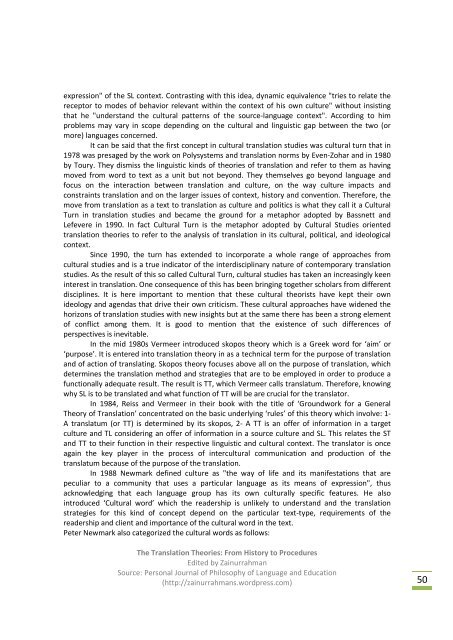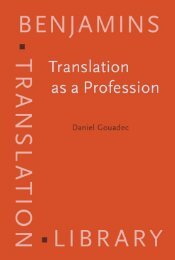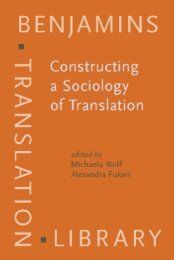Translation Theories.pdf
Translation Theories.pdf
Translation Theories.pdf
You also want an ePaper? Increase the reach of your titles
YUMPU automatically turns print PDFs into web optimized ePapers that Google loves.
expression" of the SL context. Contrasting with this idea, dynamic equivalence "tries to relate the<br />
receptor to modes of behavior relevant within the context of his own culture" without insisting<br />
that he "understand the cultural patterns of the source-language context". According to him<br />
problems may vary in scope depending on the cultural and linguistic gap between the two (or<br />
more) languages concerned.<br />
It can be said that the first concept in cultural translation studies was cultural turn that in<br />
1978 was presaged by the work on Polysystems and translation norms by Even-Zohar and in 1980<br />
by Toury. They dismiss the linguistic kinds of theories of translation and refer to them as having<br />
moved from word to text as a unit but not beyond. They themselves go beyond language and<br />
focus on the interaction between translation and culture, on the way culture impacts and<br />
constraints translation and on the larger issues of context, history and convention. Therefore, the<br />
move from translation as a text to translation as culture and politics is what they call it a Cultural<br />
Turn in translation studies and became the ground for a metaphor adopted by Bassnett and<br />
Lefevere in 1990. In fact Cultural Turn is the metaphor adopted by Cultural Studies oriented<br />
translation theories to refer to the analysis of translation in its cultural, political, and ideological<br />
context.<br />
Since 1990, the turn has extended to incorporate a whole range of approaches from<br />
cultural studies and is a true indicator of the interdisciplinary nature of contemporary translation<br />
studies. As the result of this so called Cultural Turn, cultural studies has taken an increasingly keen<br />
interest in translation. One consequence of this has been bringing together scholars from different<br />
disciplines. It is here important to mention that these cultural theorists have kept their own<br />
ideology and agendas that drive their own criticism. These cultural approaches have widened the<br />
horizons of translation studies with new insights but at the same there has been a strong element<br />
of conflict among them. It is good to mention that the existence of such differences of<br />
perspectives is inevitable.<br />
In the mid 1980s Vermeer introduced skopos theory which is a Greek word for ‘aim’ or<br />
‘purpose’. It is entered into translation theory in as a technical term for the purpose of translation<br />
and of action of translating. Skopos theory focuses above all on the purpose of translation, which<br />
determines the translation method and strategies that are to be employed in order to produce a<br />
functionally adequate result. The result is TT, which Vermeer calls translatum. Therefore, knowing<br />
why SL is to be translated and what function of TT will be are crucial for the translator.<br />
In 1984, Reiss and Vermeer in their book with the title of ‘Groundwork for a General<br />
Theory of <strong>Translation</strong>’ concentrated on the basic underlying ‘rules’ of this theory which involve: 1-<br />
A translatum (or TT) is determined by its skopos, 2- A TT is an offer of information in a target<br />
culture and TL considering an offer of information in a source culture and SL. This relates the ST<br />
and TT to their function in their respective linguistic and cultural context. The translator is once<br />
again the key player in the process of intercultural communication and production of the<br />
translatum because of the purpose of the translation.<br />
In 1988 Newmark defined culture as "the way of life and its manifestations that are<br />
peculiar to a community that uses a particular language as its means of expression", thus<br />
acknowledging that each language group has its own culturally specific features. He also<br />
introduced ‘Cultural word’ which the readership is unlikely to understand and the translation<br />
strategies for this kind of concept depend on the particular text-type, requirements of the<br />
readership and client and importance of the cultural word in the text.<br />
Peter Newmark also categorized the cultural words as follows:<br />
The <strong>Translation</strong> <strong>Theories</strong>: From History to Procedures<br />
Edited by Zainurrahman<br />
Source: Personal Journal of Philosophy of Language and Education<br />
(http://zainurrahmans.wordpress.com) 50

















